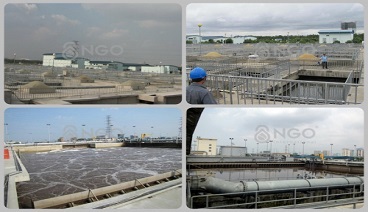NGO News – While more than 40% of hospitals all over Vietnam have not been equipped with standardized treatment system, the treatment of hospital wastewater is getting more urgent to protect our environment, prevent the risk of water pollution and disease spread.

1. Compositions of hospital effluent
Hospital wastewater usually contains organic substances, animal fat and vegetable oil, mineral impurities and organic substances, pathogens, drug residues, disinfectants, chemical solvents, Antibiotic residues and may have radioactive isotopes…
Hazardous elements included in hospital wastewater as follows:
- Chemicals (surfactants and stabilizers) are derived from the X-ray room.
- The dental area where mercury (Hg) is probably discharged into wastewater.
- Department of infection prevention is the place where disinfectant is most popularly used. In which, aldehyde disinfectant is commonly used which increases the level of pollution in wastewater.
- Kitchen in the hospital often emits large amount of organic matter, animal fat and vegetable oil related to food processing into the waste water.
- Laundry area makes pH concentration in wastewater higher and ncreases phosphate content and especially chlorine compounds deriving from the used disinfectants. In the treatment area, the amount of antibiotics, disinfectants (glutaraldehyde) makes wastewater more polluted.
- Laboratory is the source of wastewater containing chemicals and the common used chemicals are halogens, organic solvents, cell (Gram stain), formaldehyde,
|
No. |
Parameter |
Unit |
Value range |
Typical value |
QCVN 28:2010 (B Column) |
QCVN 28:2010 (A Culumn) |
|
1 |
BOD5 |
Mg/l |
120-250 |
170 |
50 |
30 |
|
2 |
COD |
Mg/l |
150-350 |
300 |
100 |
50 |
|
3 |
SS |
Mg/l |
100-200 |
180 |
100 |
50 |
|
4 |
Amoni |
Mg/l |
30-60 |
40 |
10 |
5 |
|
5 |
Phosphat |
Mg/l |
10-30 |
25 |
10 |
6 |
|
6 |
Coliform |
MPN/100 ml |
106 – 109 |
106 – 107 |
5000 |
3000 |
Table 1: Typical parameter of hospital effluent
2. How does Hospital Effluent affect human life and environment?
For Humans:
- Pathogenic bacteria in wastewater can cause disease to humans and animals via water source, vegetables watered by wasterwater.
- Using polluted water souces by hospital effluent can lead to the risk of skin diseases and fatal disease.
For Environment:
- Hospital Effluent discharing directly into water resources without treatment or substandard treatment can pollute surface water source such as ponds, lakes, river as well as underground water sources, leading to the fact that toxis substances entering plants, accumulated in the food chain of humans.
3. Hospital wastewater treatment process
Procedure of hospital wastewater treatment including following main stages: Pre-treatment, primary treatment, secondary treatment and after treatment
3.1. Pre-treatment stage:
This is very important step in wastewater treatment in general to ensure the efficient operation of whole system. If this stage is not well operated, it shall impact on the stability of hospital wastewater treatment system. The pre-treatment stage is implemented as below:
- Wasterwater from canteens and cafeterias usually contains large amount of animal fat and vegetable oil, therefore oil & grease separation system shall be designed at this stage to remove fat and grease before discharging wastewater into the general collection system of hospital.
- Specific wastewater sources generate from laboratories, dental clinics, chemotherapy, laundry areas, etc. should be preliminarily treated before discharging into the collection system.
3.2. Primary treatment stage:
Primary wastewater treatment stage can remove suspended solids if it is standardly designed. After pre-treatment stage, concentration of COD, BOD in hospital wastewater is significantly reduced. Technical devices used for this process normally include: Screening, primary sedimentation tank and balancing tank.
Screening
- Removing trash in the wastewater before discharging into the central treatment plant to protect the pump from being clogged.
- Types of screen can be used: coarse screen and fine screen.
- Calculate and choose suitable type and position of screening with flow rate and characteristics of wastewater
Primary sedimentation tank:
- Separating sand and inorganic compounds.
- Two main types of primary sedimentation tank are vertical sedimentation tank and two-shell sedimentation tank.
3.3. Secondary treatment
Secondary processing stage is the removal stage of dissolved carbon, nitrogen & phosphorus compounds under the micro-organism reaction in the effluent. Secondary treatment techniques commonly use in hospital wastewater treatment facilities in Vietnam include:
- Biofilter tank
- Submerged biofilter tank
- Trickling filtered tank
- Rotating Biological Contactor
- Conventional aerobic tank
- Sequencing Batch Reactor
- Oxidation ditch
3.4. Post-treatment stage
Post-treatment or the disinfection of wastewater is the final step in hospital wastewater treatment before discharging directly into the receiving sources. The popular methods of wastewater disinfection includes:
- Ultraviolet sterilization
- Sterilization with chlorine or chlorine compounds
- Sterilization with ozone
In additional, after post-treatment process, sludge need to be treated.
4. Hospital effluent treatment technologies popularly applied in Vietnam
- Biological Trickling filter
- Activated sludge process
- Hospital wastewater treatment based on integrated principle
- AAO technology Bio-stabilization pond
- MBR technology
In general, each of the above technologies has its own advantages and disadvantages, therefore investors should select the appropriate hospital wastewater treatment solution upon consideration of various factors such as construction area, investment capital, and experience of the solution providers.
More at:
https://shopngoenvironment.com/product/thiet-bi-mang-loc-e-mbr/
https://shopngoenvironment.com/product/mang-loc-mbr-x/
***Vui lòng đọc kỹ yêu cầu về Điều khoản sử dụng – Bản quyền trước khi sao chép hoặc trích dẫn nội dung và hình ảnh của website.
Trang web này thuộc bản quyền của Công ty TNHH Quốc tế NGO (NGO International). Bất kỳ hình thức sử dụng hoặc sao chép một phần hoặc toàn bộ nội dung dưới mọi hình thức đều bị nghiêm cấm, trừ trường hợp được sự cho phép rõ ràng bằng văn bản từ Chúng tôi.
Nguồn: NGO

 Tiếng Việt
Tiếng Việt





